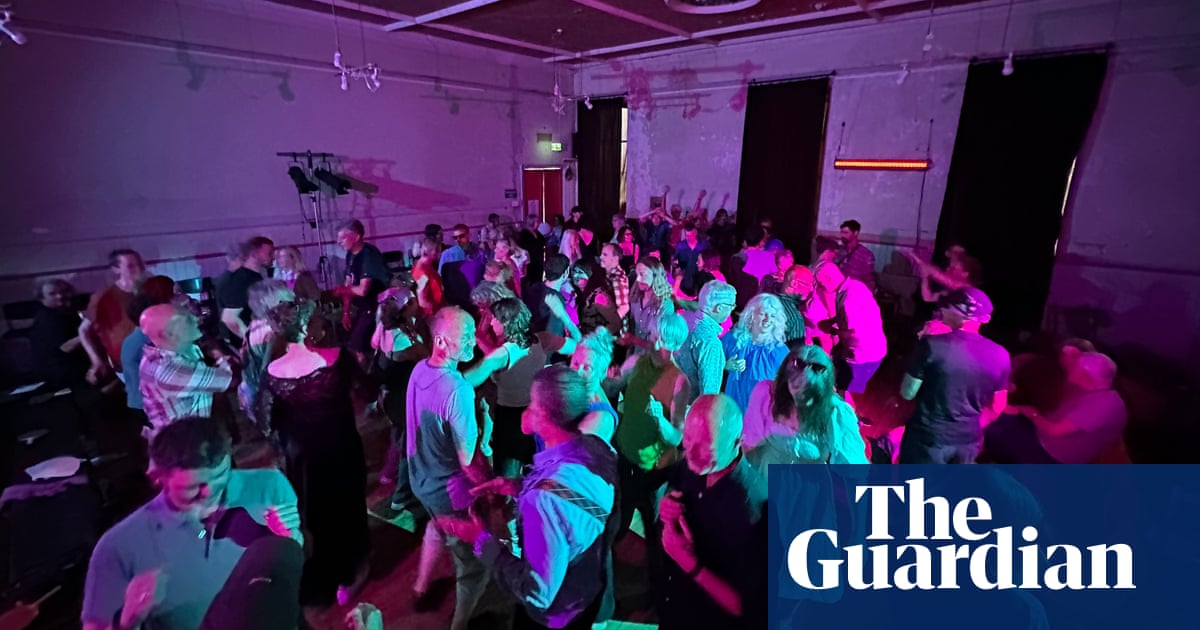
Donna Summer’s I Feel Love kicks in and everybody’s up and dancing. Arms are in the air, one woman’s standing on a chair with half-closed eyes, big grins everywhere. It’s Friday night in a former Sunday school hall above Wainsgate Chapel, in Hebden Bridge’s Old Town. Not usually a disco hotspot, but unexpected things happen at this little wellspring of dance that’s popped up on the hill, looking out over the green Calder Valley.
Tonight it’s performers Jo Fong and George Orange and their poignant and silly show The Rest of Our Lives, a packed house of 80 punters fully invested in the audience participation. Over the last six years, a range of left-field choreographers have come to create and share work here, some of which has gone on to be performed at the Barbican, V&A and Sadler’s Wells. Spice Girl Mel C was even here not long ago, rehearsing for her contemporary dance debut. “We’ll have Beyoncé next,” jokes Charlie Morrissey, founder of Wainsgate Dances.
Really, though, Morrissey is far less interested in Beyoncé than he is the local community in which he’s become embedded since moving here with partner Rob Hopper eight years ago. They had no idea when they arrived in Yorkshire from Brighton that this project was ahead of them. They discovered the 19th-century chapel on a walk one day. It had some artists’ studios inside, but the hall upstairs was mainly being used for storage, stacked with miscellany. Being the sort of person whose energy needs an outlet, when Hopper (a ceramicist) took on a studio, Morrissey started to get involved in the building: cleaning, sorting things out, sanding the wooden floor, and proposing he start some dance here. The chapel is also used for concerts and other events, and Morrissey joined the committee that runs it and gradually set about making the space more usable, putting in a kitchen, new toilets and heating.
“It’s a huge amount of work, to be honest,” says Morrissey, but he admits “it’s a bit of an obsession for me”. Morrissey has worked as a dance artist for decades, performing and teaching in the UK and internationally. Too often he finds himself in negative conversations with other artists, bemoaning funding cuts. “I don’t want to spend any more energy doing that,” he says. He wants to direct that energy somewhere positive instead. “You do it because it’s hopeful,” says Hopper.
The aim at Wainsgate is to keep everything “low admin, low tech”, so when artists come for residencies, they stay at Morrissey and Hopper’s house, or with other friends of theirs in the village. There’s a huge sense of community here. We can’t walk two metres along the road without bumping into someone Morrissey knows: there’s Eddy in his van, he put the heating in at Wainsgate; Sarah who runs the shop, she does the door for shows sometimes; dance artist Lucy Suggate works in the cafe (where they do a mean lemon drizzle, with a mug of Yorkshire Tea, naturally).
It’s not only professional artists who come to dance at this idyllic spot, where light floods through tall windows and the mood is serene. Every weekday morning, Morrissey runs an “open practice” from 9-10am where anyone, regardless of dance experience, can come and move in their own way to his daily playlist (“Motörhead one second, Scarlatti the next”). You’ll see an 82-year-old in a chair, next to a three-year-old and his dad, next to a professional dancer “tearing through space”.
Julia Maybury is the 82-year-old in question. “I’ve got a pacemaker and arthritis in my feet, but I still manage to get there every morning,” she says. “It’s a wonderful floor to move on, the light that comes through in the morning, the birds flying outside, a horse that chomps away on the field on one side. It’s just a beautiful space.”
“The main thing I feel when I walk into that building is just freedom,” says Kathleen Arber, 46, another local who loves the lack of expectations about how to move, and the time to be herself away from life’s other responsibilities. “If I’ve got something bothering me, I find that you can sort of dance through it,” she says. “You sometimes get clarity on your problems. It sounds hippy-dippy, but you can literally move through it, by listening to your body.” Maybury agrees that it’s enriching: “Being able to move, and move with friends, and make new friends. You know, we have tragedies in our life, and the dance supports us.” “It’s been such a gift to the local community,” says Arber.
Back at The Rest of Our Lives, there’s an enthusiastic local audience of all ages. Christopher Anderson, who works in IT, moved here two years ago and is helping run the bar tonight. “When we were in London we didn’t go to the theatre, now we see loads. It feels like a cultural explosion,” he laughs.
In London, Morrissey would find himself at shows full of other dancers “comparing themselves with each other”. Here it’s different: most people in the audience don’t have much experience of contemporary dance, “but they’re really curious about it”, says Morrissey. A lot of what happens at Wainsgate is at the more experimental end of the art form, but Morrissey says: “You don’t need to try to make work accessible by making the work different. You need to make the space accessible. And the invitation, the way you talk about it, the way that you meet people at the door and welcome them.” He doesn’t mind if people don’t like it. “We can have a chat about it later. We always try to make room to socialise afterwards. People come and hang out.”
At one fairly avant-garde show, which included someone re-enacting a John Cage piece with props including a bathtub, rubber duck, watering can and soda siphon, Morrissey got chatting to a man who’d come along. “He told me, ‘Oh yeah, I just drive the school bus and one of the mums told me about it’,” Morrissey remembers. “He said, ‘I’ve never seen anything like it. But I’m definitely coming back’.”












